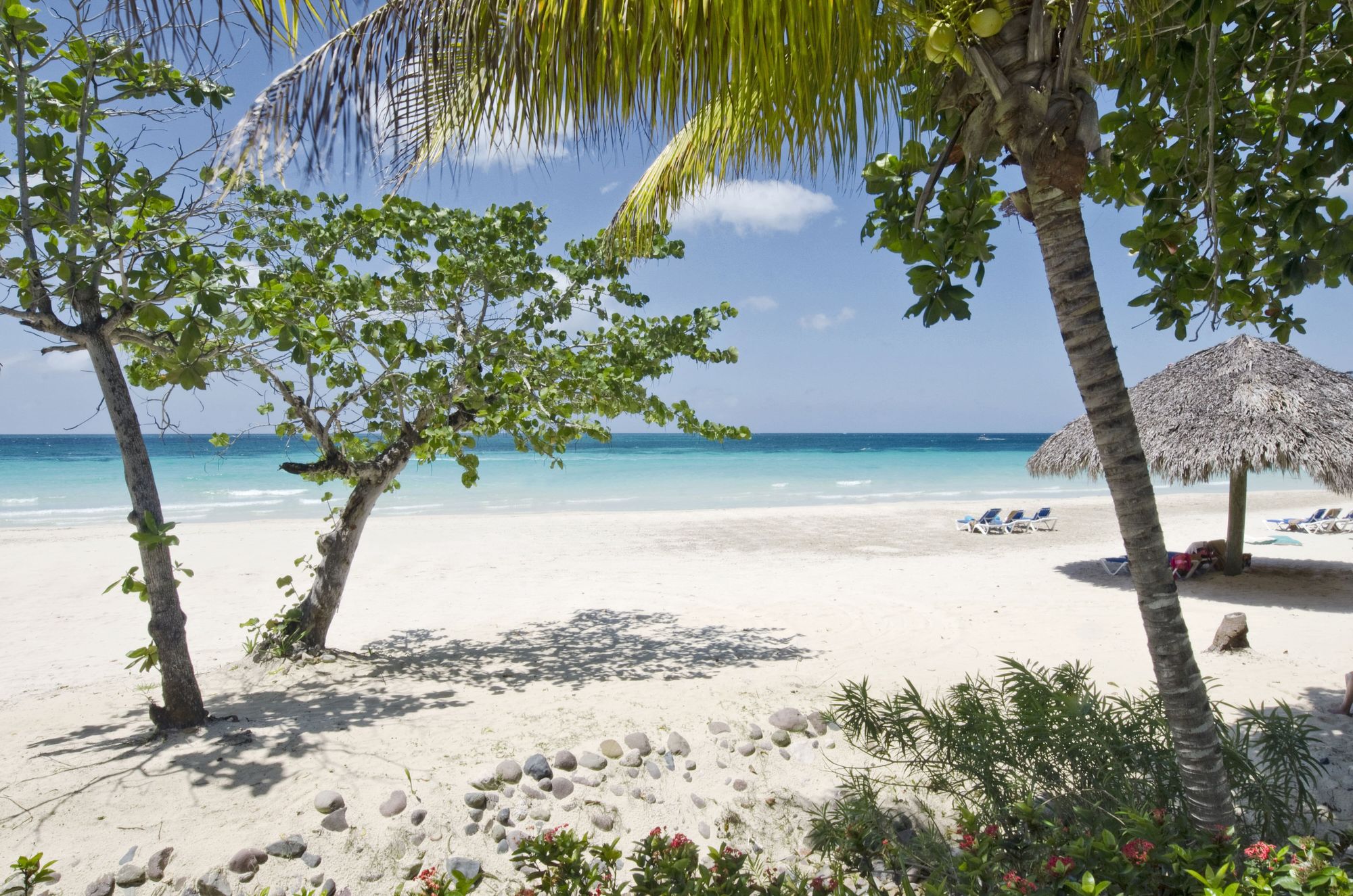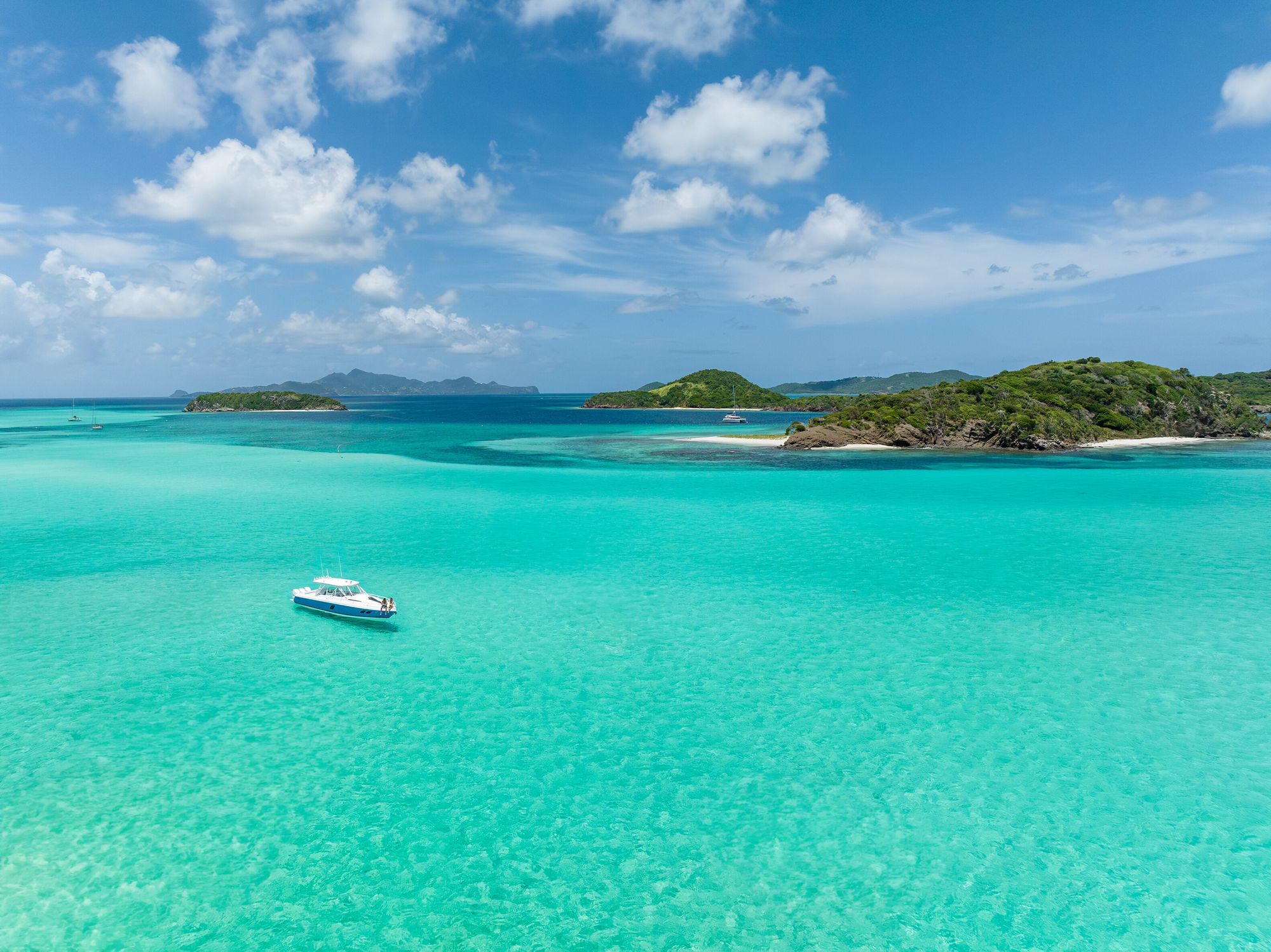The 28 Best Scuba Diving Sites In The Caribbean
The contrast between the peace that comes with scuba diving and the busy, often chaotic pace of regular life draws many people to spend time beneath the waves. The warm and clear waters of the Caribbean are a great place to have an awesome underwater adventure.
Framed by amazing white sandy shores, the Caribbean’s beaches are a great starting point for the best scuba diving experiences. Divers from all over the world travel to this region for its stunning dive sites, which often include ancient wrecks and colorful reefs with vibrant marine life. You’ll likely come across sea creatures that are as fascinated by you as you are by them.
Some of the best places for diving in the Caribbean include The Bahamas, the Turks & Caicos Islands, Barbados, Saint Lucia, Jamaica, Antigua, and Grenada. In this article, we’ll explore some of the best dive sites you can find on each of these incredible islands, and what makes each stand out!
Best dive sites in Jamaica
Once you’ve tried scuba diving, you either love it, or you really love it – and that’s the magic of the undersea. In Jamaica, there are many cool dive sites including the Throne Room, Widow Maker Cave, the Arch, and more. We’ve listed some of the most popular ones, but you can check out our full list of amazing dive sites in Jamaica for more.
The Throne Room
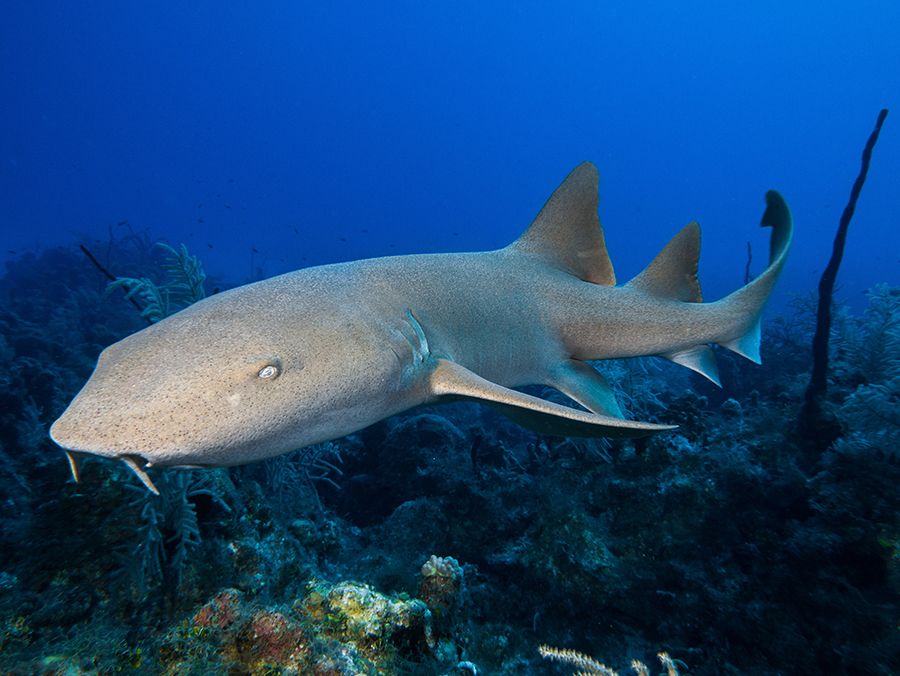
Dive level: Novice
Accessible from: Sandals Negril
There are nearly two dozen dive sites around Negril, and the Throne Room is among the most highly recommended. Divers love this location because there’s always so much to see, including unique coral formations, stingrays, eels, octopus, barracuda, snapper, and occasionally, dolphins and nurse sharks. The name of this reef is inspired by the throne-shaped elephant ear sponge that is a prominent feature in the underwater cavern (around 60 ft below).
Widow Maker Cave
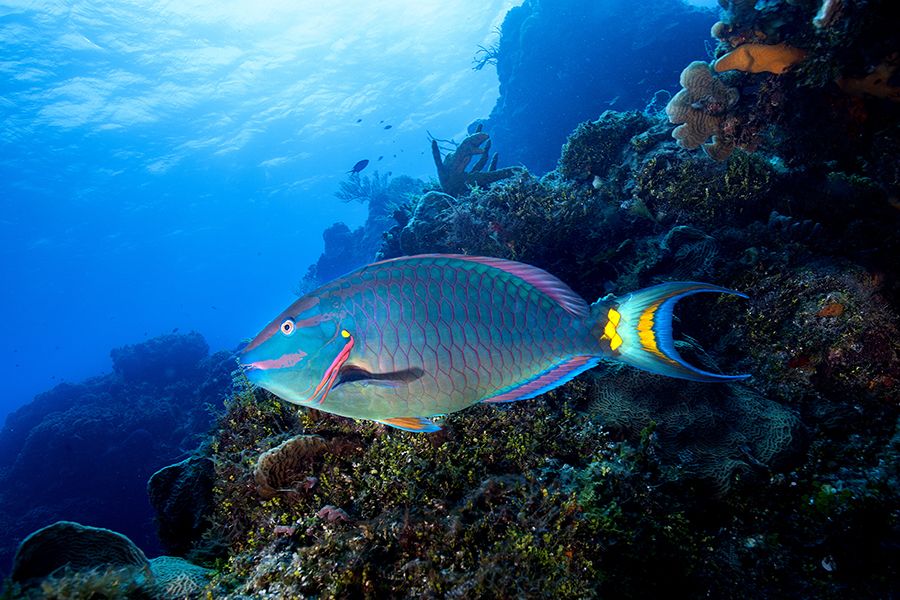
Dive level: Advanced
Accessible from: Sandals Montego Bay and Sandals Royal Caribbean
Widow Maker Cave is one of the best dive sites in Montego Bay. The cave is around 35 ft beneath the surface and it extends down to about 80 ft. Its walls are covered with black coral and other types of soft coral. Divers can choose to start their dive from the shallower cave opening or the exit at 80 ft. Sightings here include parrot fish, barracuda, and more. This two-in-one dive is ideal for more experienced divers.
The Arches
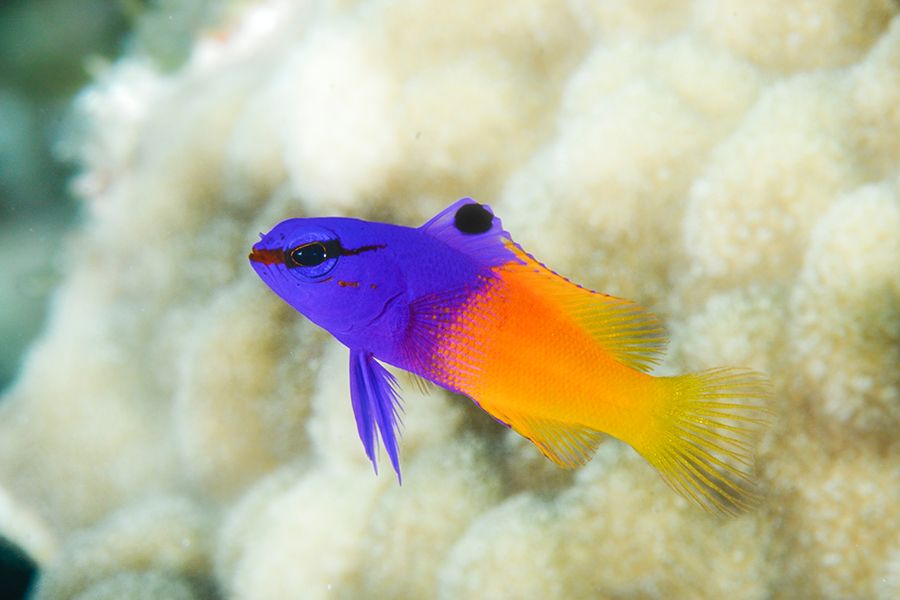
Dive level: Advanced
Accessible from: Sandals Montego Bay and Sandals Royal Caribbean
The Arches and the Caves are fascinating rock structures, and divers often see rays and sharks there. The caves are near shore (just about 10 minutes away) and include two caverns that are connected by a narrow tunnel. Down at the 40-60 foot mark, divers can swim through the Arches, wall dive, and explore the various ledges and overhangs. Expect to see plenty of purple and yellow fairy bassets!
English Reef
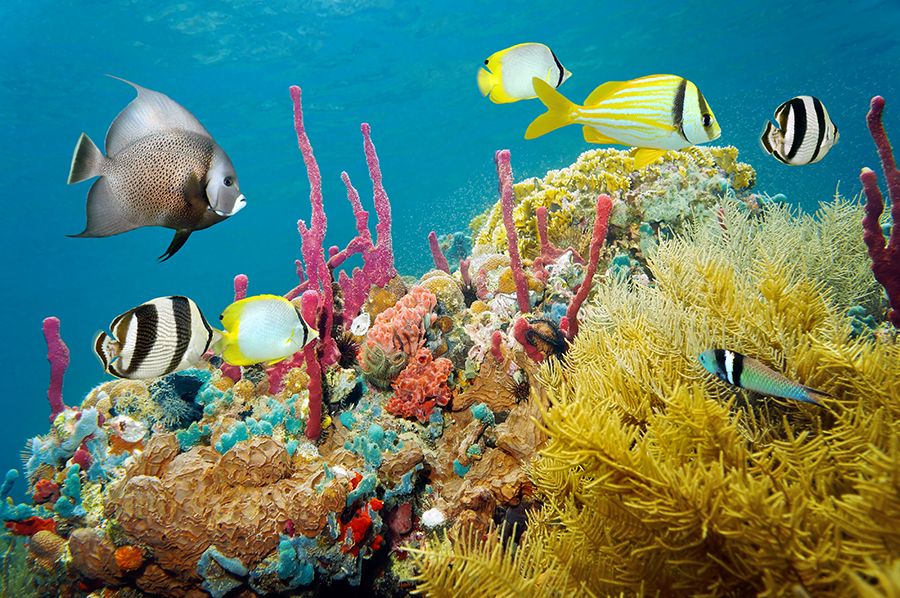
Dive level: Advanced
Accessible from: Sandals South Coast
English Reef is great for deep diving and is a top choice for divers who know their way around the water. The reef is quite expansive and ranges from 65 ft to 100ft. Visibility is also exceptional here, right on through to the 80 ft mark. While this isn’t one of the most well-known or talked about dive sites in Jamaica, it’s great for divers who want a bit more of a challenge in their dive.
Best scuba sites in Saint Lucia
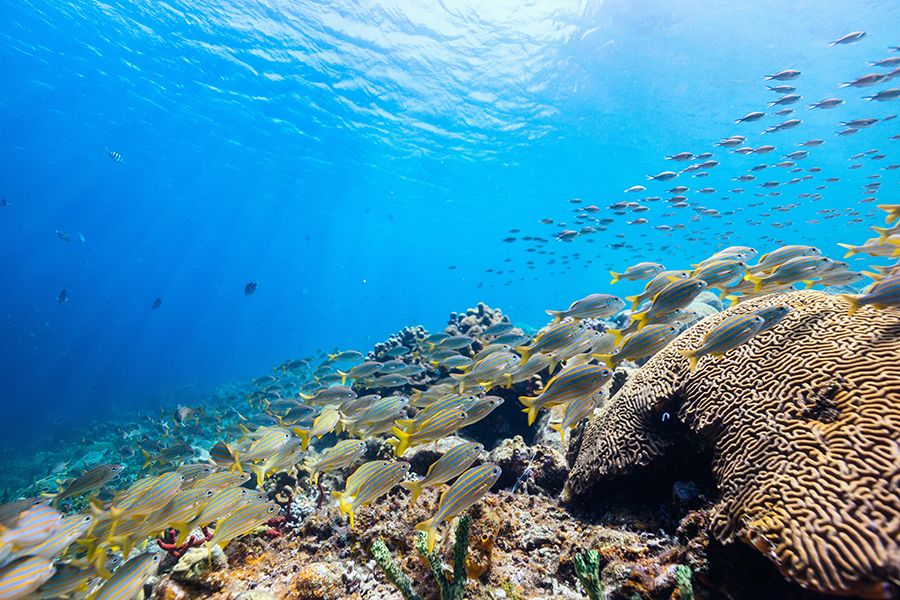
Saint Lucia is a diver’s paradise and offers many options for divers, whether they are experienced or just starting off. Below, we’ve listed a few of the most popular sites for scuba diving in Saint Lucia!
Keyhole Pinnacle
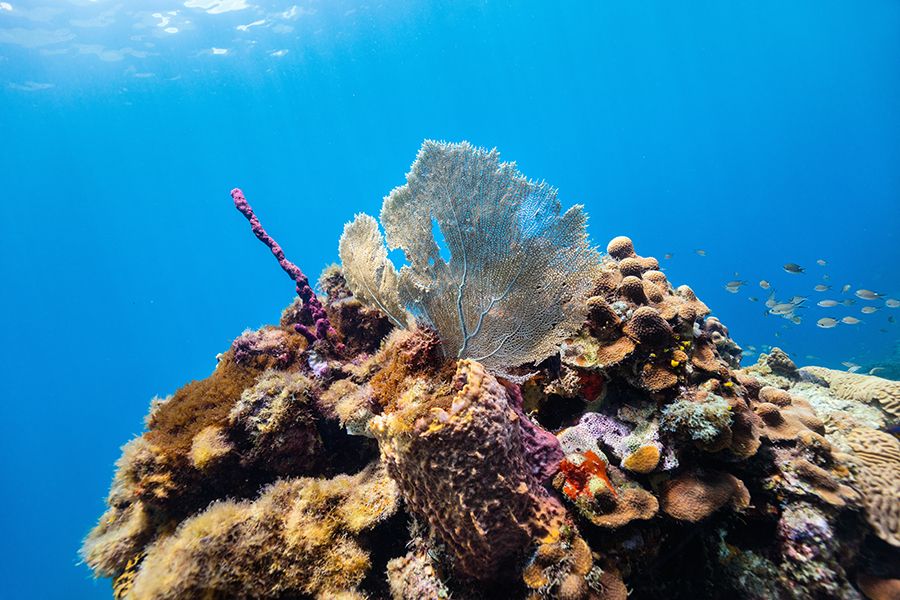
Dive level: Advanced
Available from: Sandals Grande St. Lucian, Sandals Regency La Toc, Sandals Halcyon Beach
Keyhole Pinnacle is the spot you want to go to if you want to experience a dive site that has been voted as one of the top 10 in the Caribbean. There are four intriguing volcanic peaks at this location that are encrusted with gorgonian and other types of coral. You never know what you’ll see at Keyhole Pinnacle, but you’re bound to encounter something exceptional. Sightings often include trumpetfish, grouper, snapper, jack, filefishes, and seahorses.
Superman’s Flight
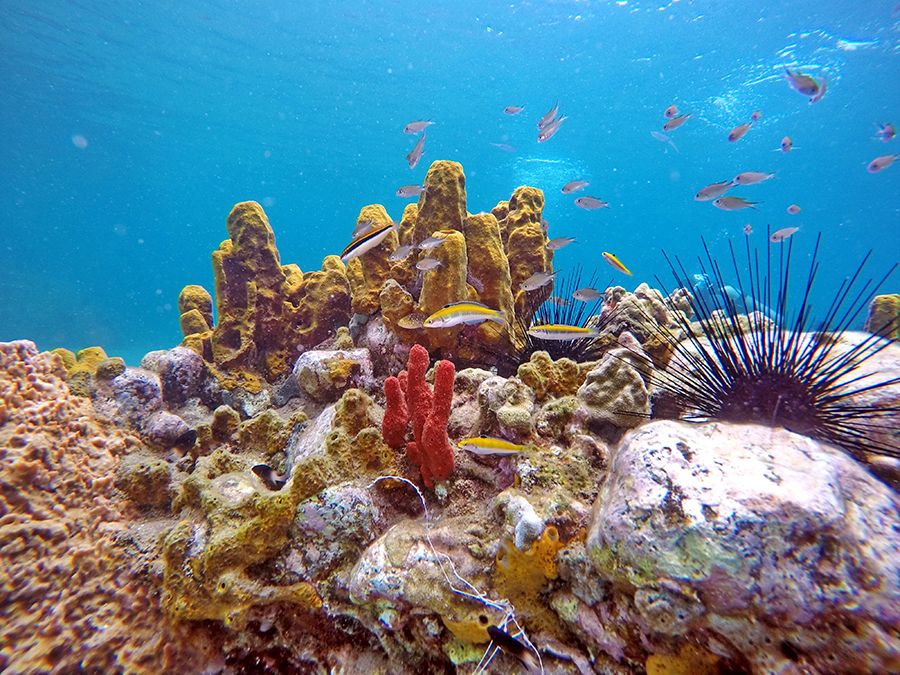
Dive level: Advanced
Available from: Sandals Grande St. Lucian, Sandals Regency La Toc, Sandals Halcyon Beach
While the name alone is reason enough to visit this dive site, as luck would have it, Superman’s Flight truly delivers. This area is named after a scene in the movie Superman II and features lots of brightly colored sponges, gorgonians, and a variety of tropical fish. You can start your dive at the base of Petit Piton, the smaller of the world-famous twin mountains in Saint Lucia, which towers at 2619 ft. This can be a drift or deep dive (if you dare) as you explore a wall surrounded by life.
Anse La Raye Wall
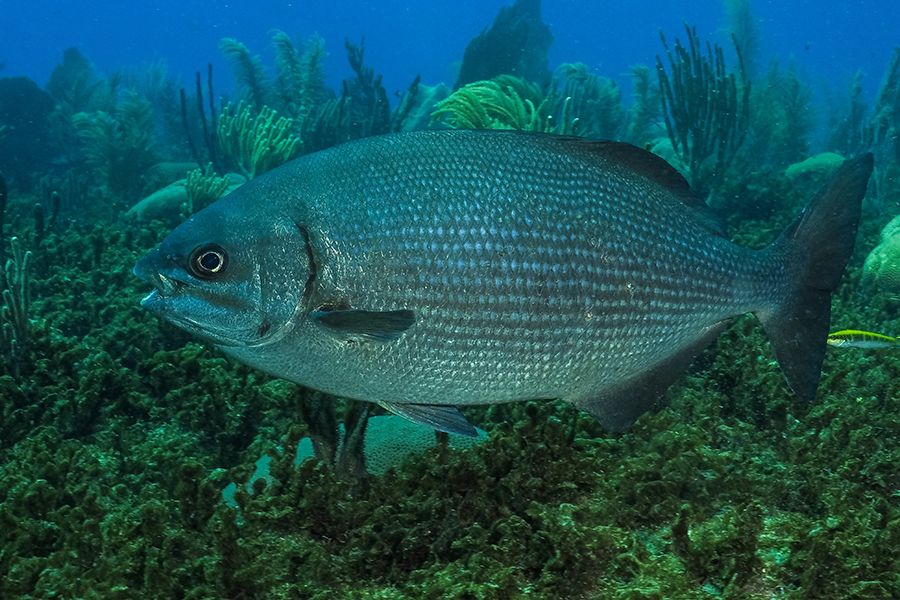
Dive level: Advanced
Available from: Sandals Grande St. Lucian, Sandals Regency La Toc, Sandals Halcyon Beach
The fishing village of Anse La Raye appeals to visitors for many reasons. One of these is the fact that this little community is known for its interesting dive opportunities. The Anse La Raye Wall is one of the most talked-about dive sites in this area. The beauty of the wall can truly be seen at about 60 ft, but you can keep going as deep as 110 ft. You’ll spot all kinds of marine life including Bermuda chubs, spotted drums, jacks, and rays, in addition to sponges and various species of soft coral.
Rosemond’s Trench
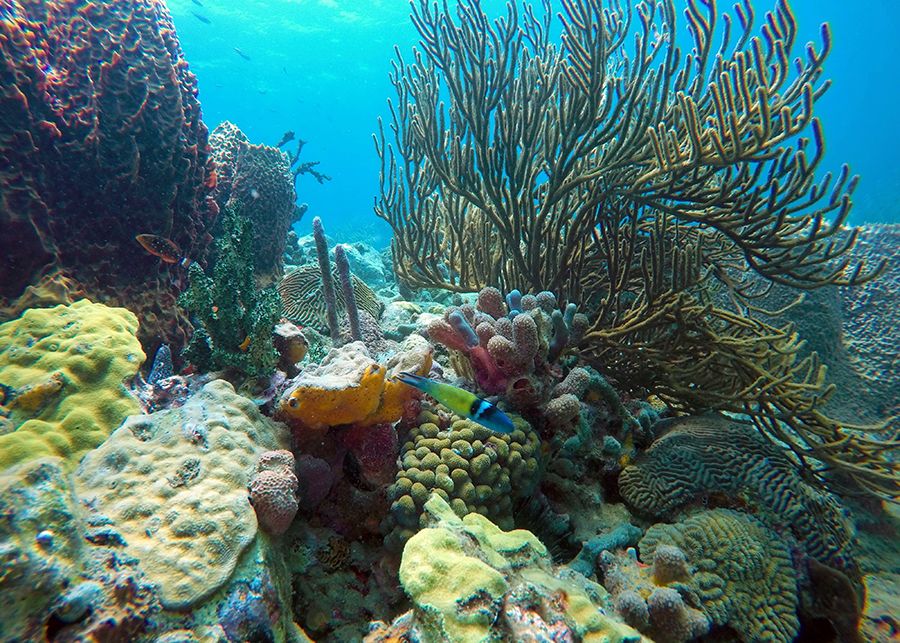
Dive level: Advanced
Available from: Sandals Grande St. Lucian, Sandals Regency La Toc, Sandals Halcyon Beach
Saint Lucia certainly delivers when it comes to unique dive sites, and Rosemond’s Trench is one of these. Many divers who’ve experienced this location label it as a “must-dive” spot where you’ll be able to see underwater valleys, trenches, and a neat little tunnel that leads to a chimney. This isn’t the deepest dive around, but there are lots of species to be spotted including frogfish, turtles, and seahorses. While diving here, look out for the unique coral shaped like the fingers of a hand!
Best scuba sites in The Bahamas
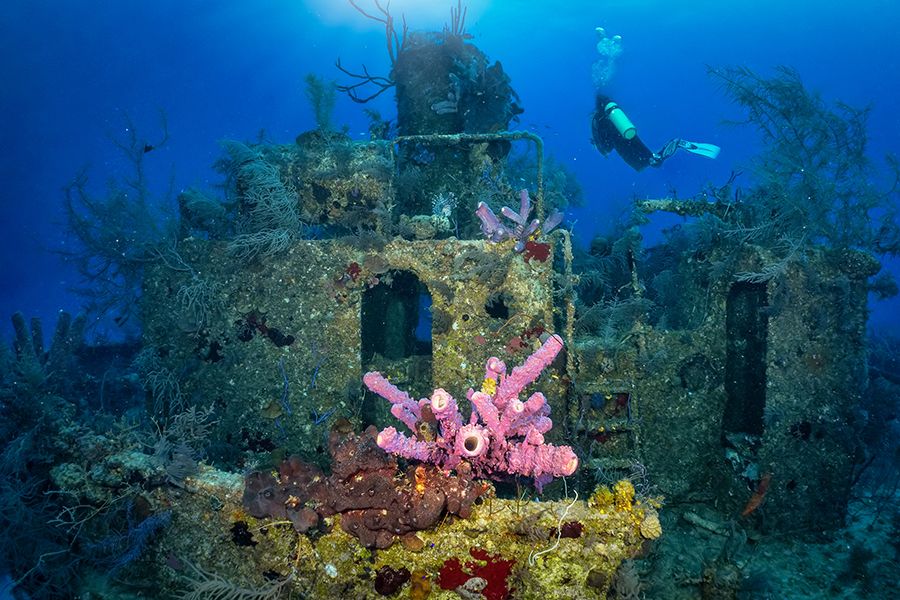
The Bahamas is famed for its world-class scuba diving! With so many great sites to choose from, it makes sense to travel there with a personalized list to start off with. Here are some of the top-rated dive sites in The Bahamas. Once you’re done with these, we’ve got a whole lot more awesome dive sites in The Bahamas for you to check out.
Mahoney Wreck
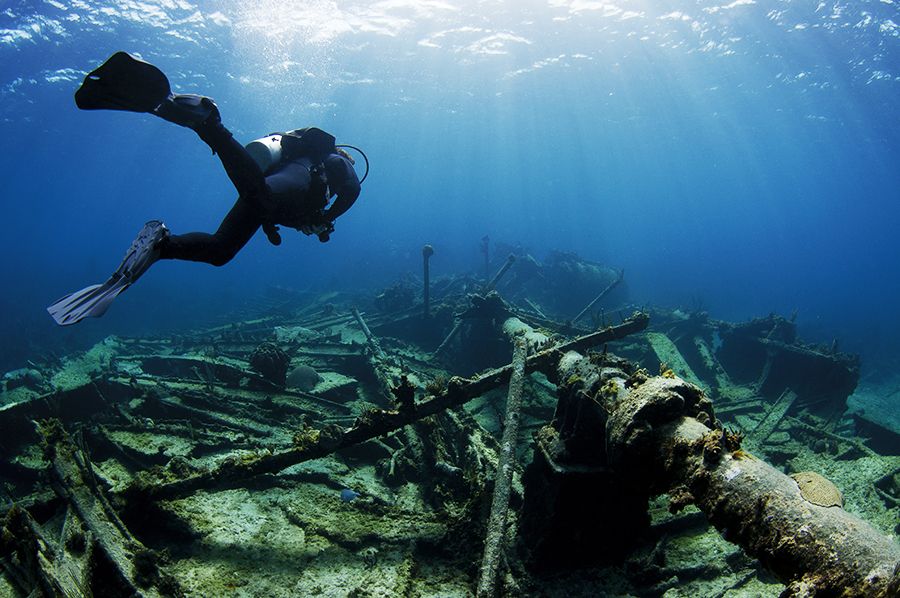
Dive level: Novice
Available from: Sandals Royal Bahamian
With so many islands to choose from, it’s hard to beat The Bahamas when it comes to diving in the Caribbean. Whether divers are looking simply to drift dive in paradise or explore ancient wrecks, they’ll find opportunities to do just that. Mahoney Wreck is one such famous wreck in The Bahamas that is located around 30 ft below the surface close to Paradise Island. The wreck itself is a steamship from the 1800s, and in the vicinity, you’ll spot fish like grouper, angelfish, snapper, grunts, pipefish, eels, and more.
Hollywood Bowl
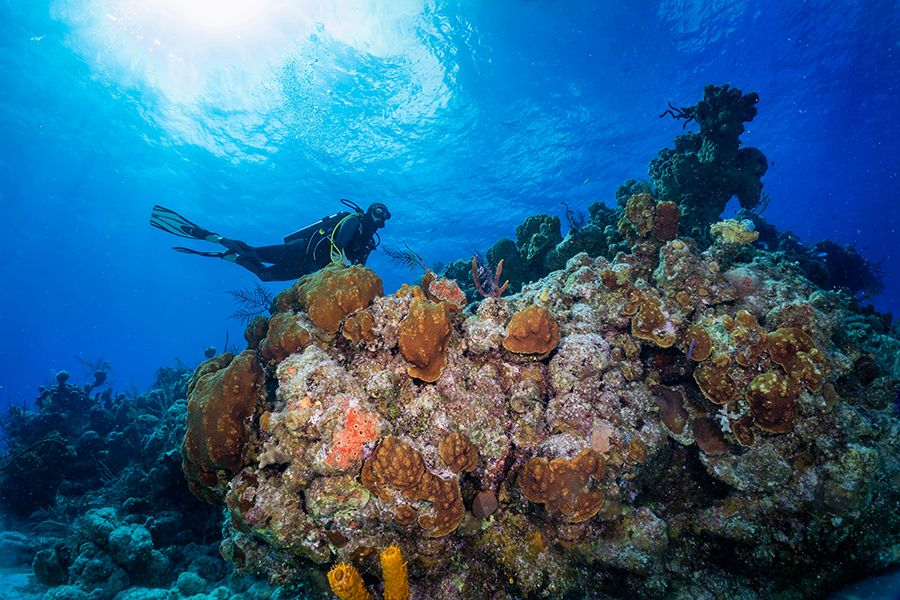
Dive level: Novice
Available from: Sandals Royal Bahamian
There are few dive sites in The Bahamas that are as well-known as Hollywood Bowl. This dive site is near Goulden Cay to the west of New Providence. Hollywood Bowl was even featured in some of the underwater scenes from the James Bond 007 movies made in the 1960s and 1970s. Other big-screen hits filmed there include ‘Splash’, ‘Into the Blue’, ‘After the Sunset’, and ‘Cocoon’. Aside from its movie-worthy ambiance, this is a great location for diving if you want to see a wide range of sea life including blue tang, Bermuda chub, sergeant majors, and more. Snorkeling and SNUBA® are also popular at the Hollywood Bowl.
Blue Hole
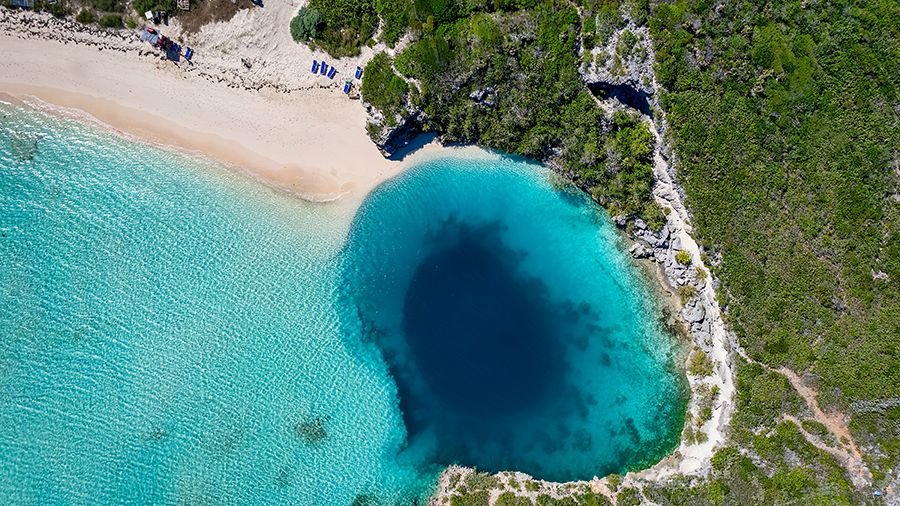
Dive level: Advanced
Available from: Sandals Royal Bahamian
It wouldn’t be a stretch to say that Blue Hole is one of the top three dive sites in Nassau, Bahamas. It can be found about nine miles from the eastern end of Nassau, and you may notice that it looks quite a bit like a doughnut! There are coral heads of varying sizes near the top of the hole, and you’ll start spotting sea life just as soon as you dive in. There are some pretty stunning rock formations down below, especially as you dive deeper. Expect to see turtles, stingrays, and occasionally sharks (especially during July and early August).
Bahama Mama
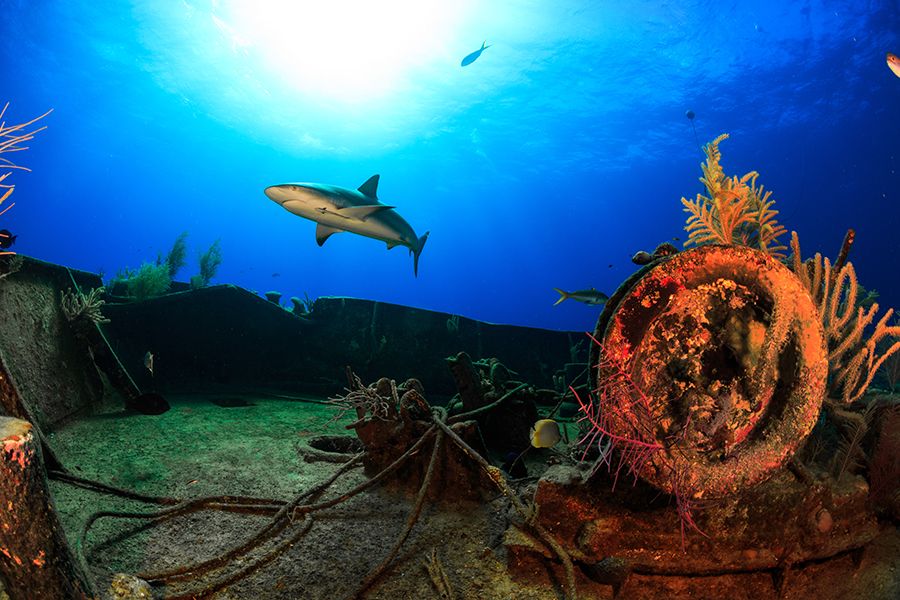
Dive level: Advanced
Available from: Sandals Royal Bahamian
Located at the end of the Tongue of the Ocean Wall, there’s a wreck about 40 ft below the surface here. It is known as the Bahama Mama and was once a party boat. Bahama Mama is famed for its out-of-this-world shark diving. That’s not the only thing this dive site is known for, however. As this dive site isn’t very far from shore, only a quick boat ride is required before you’re all set to dive. Apart from checking out wrecks like the Bahama Mama and the fully intact Ray of Hope, which is also located nearby, you can spend your time exploring the wall or reefs and looking out for lobster, stingrays, and Bahamian reef sharks.
Best scuba sites in Barbados
You can’t go wrong with a dive vacation in Barbados, especially with sites like the Carlisle Bay Marine Park (listed below), which gives divers the opportunity to see many different wrecks, each with an interesting history, all in one place.
Carlisle Bay Marine Park
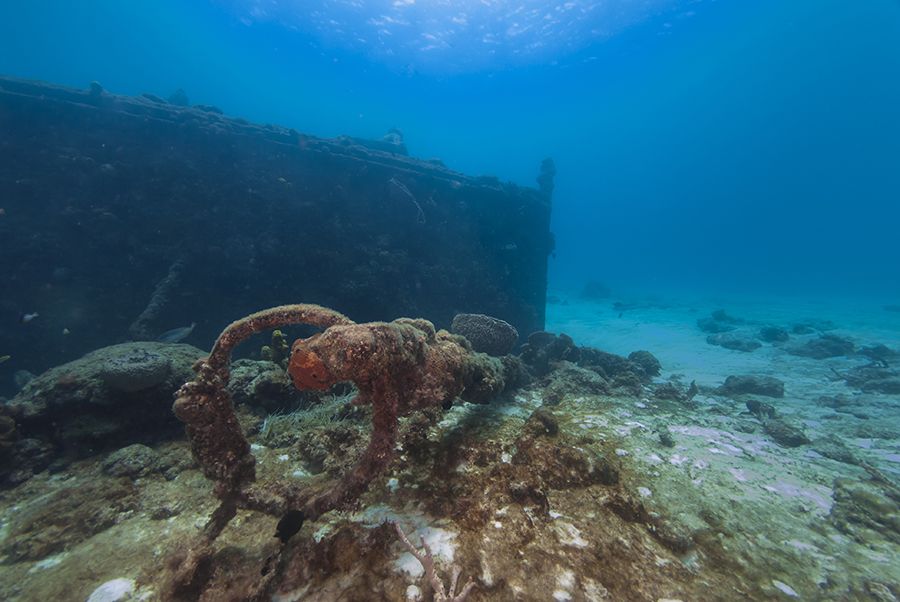
Dive level: Novice
Available from: Sandals Barbados, Sandals Royal Barbados
Carlisle Bay is shallow and calm, making it popular with wreck divers. Wrecks in the area include The Berwyn, a World War I French tugboat (7-10 ft beneath the surface), the 45 ft Cetrek to the northern end of the park, the 110 ft Eillon (once a drug runner), the Canadian freighter Cornwallis (struck by a German U-Boat torpedo during World War II), the Bajan Queen party boat, and The Barge, which was once a Naval Landing Barge. Other than the wrecks, there’s lots of sea life to see here including porcupine fish, golden spotted eels, and seahorses.
Dottins Reef
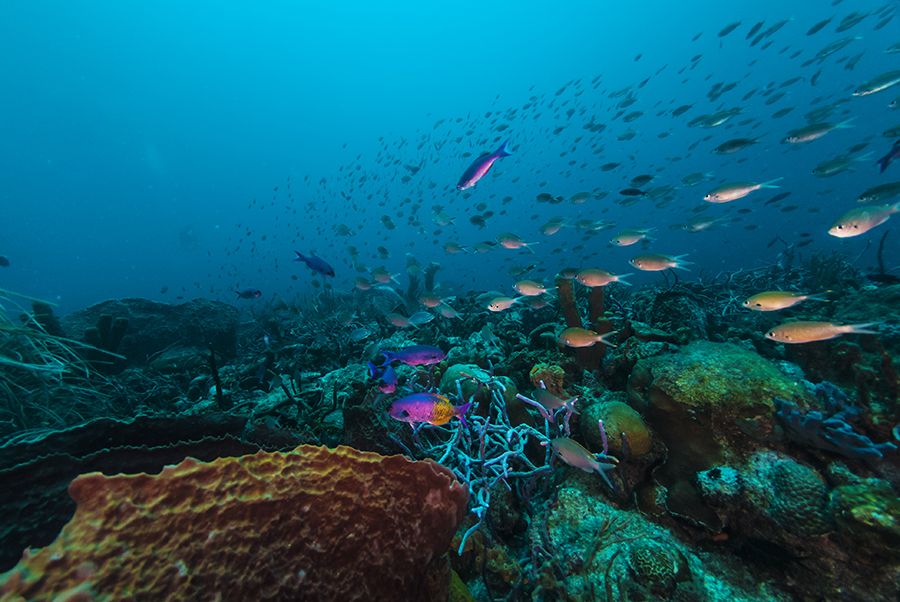
Dive level: Novice
Available from: Sandals Barbados, Sandals Royal Barbados
Dottins Reef, on the west coast of Barbados, is popular with the dive crowd and is suitable for divers who don’t have a lot of experience. You can gain access to this reef (which ranges in depth from 40 to 100 ft) via Holetown. Even though it’s a great site for newbie divers, more experienced divers can still have a good time swimming with yellowtails, bar jacks, turtles, barracuda, and so much more!
Mount Charlie
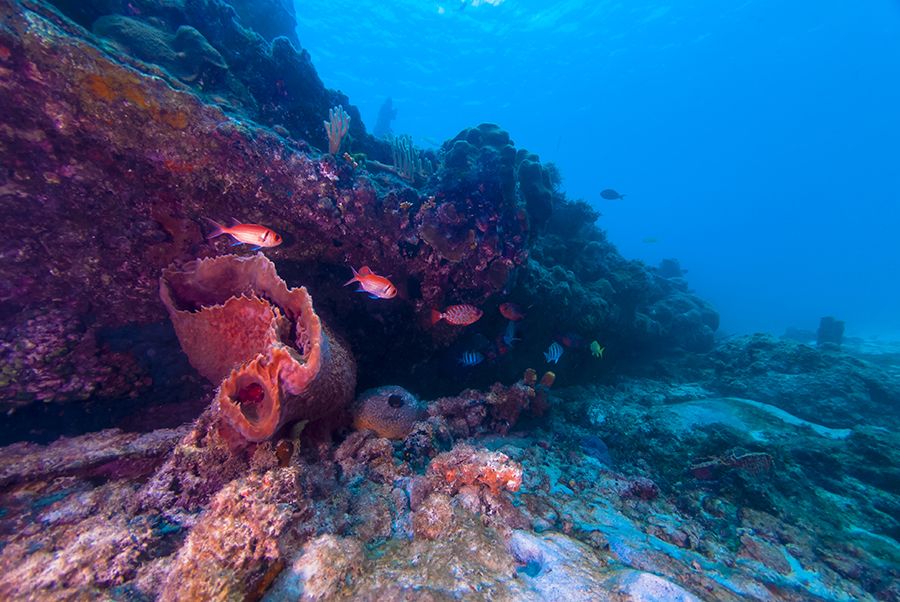
Dive level: Advanced
Available from: Sandals Barbados, Sandals Royal Barbados
Barbados is a coral limestone island, making the underwater scene around the island different from most other islands in the Caribbean. There’s a wide variety of coral to be seen at dive sites like Mount Charlie (off Dover) in Barbados, which is best for skilled divers looking for some adventure. Expect lots of colors and thriving sea life at this outer barrier reef, including snapper, horse-eye jacks, turtles, and barracuda. This dive site is on the deeper end, ranging from 70 ft to 120 ft. It is the ideal dive site for underwater photography.
SS Stavronikita Wreck
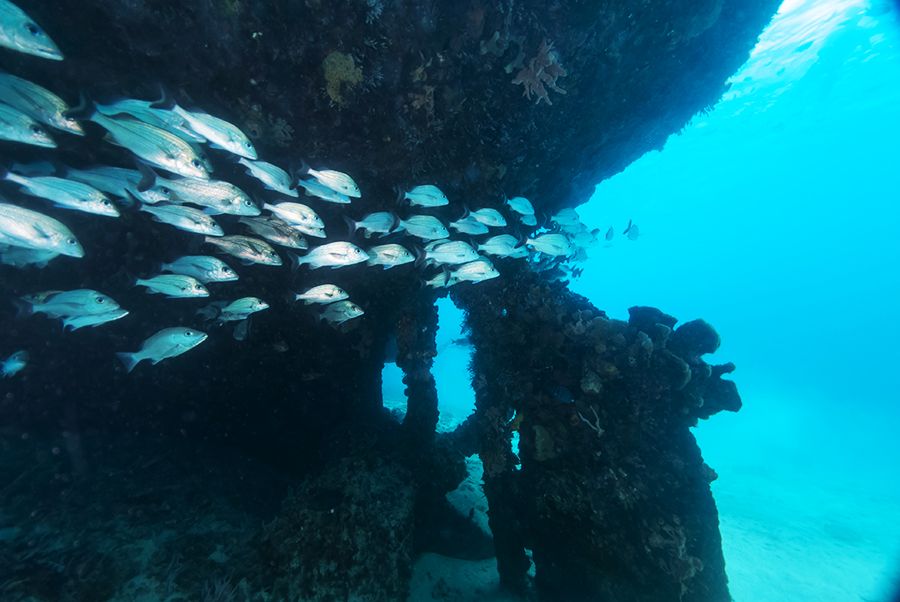
Dive level: Advanced
Available from: Sandals Barbados, Sandals Royal Barbados
Even though it is the most famous dive site in Barbados, diving the SS Stavronikita Wreck can be a bit of a challenge. Once you’re in the water, it’s possible to see the wreck itself starting from the 20ft mark. The Stavronikita Wreck, however, is actually 140 ft beneath the surface. Once a Greek freighter ship, the SS Stavronikita was purposely sunk in 1978 after an extensive fire on board. This is a great dive site to save for last, as it will really feel like the cherry on top of an amazing experience. The SS Stavronikita is about 230 ft from shore.
Barbados has some of the best scuba diving in the Caribbean. Here are some more amazing scuba sites on the island of Barbados!
Best dive sites in Grenada
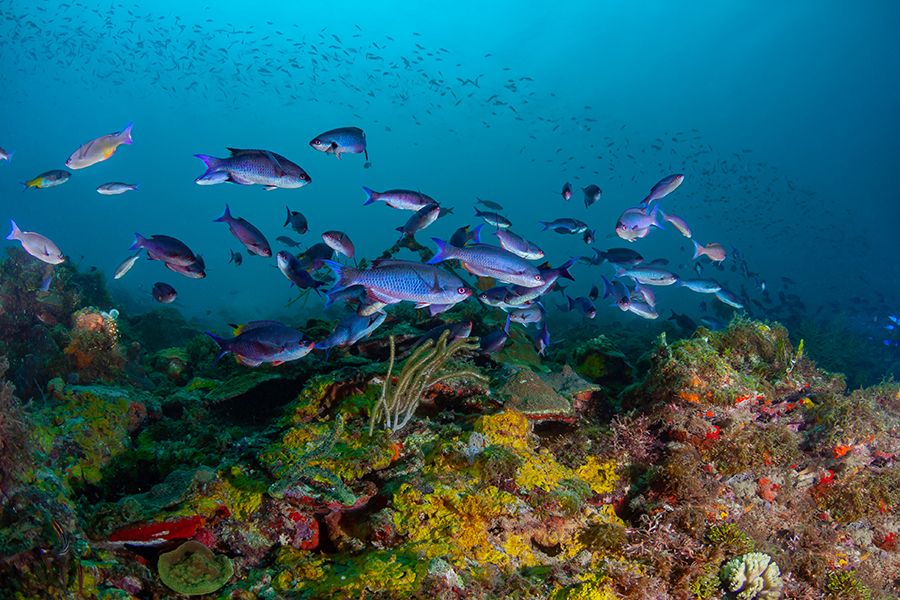
Grenada is known for many things, including its amazing beaches and dive sites. Some of the most popular include Purple Rain (listed below), Kohani, and Flamingo Bay. Apart from the ones listed here, there are many more scuba diving spots to enjoy in Grenada.
Purple Rain
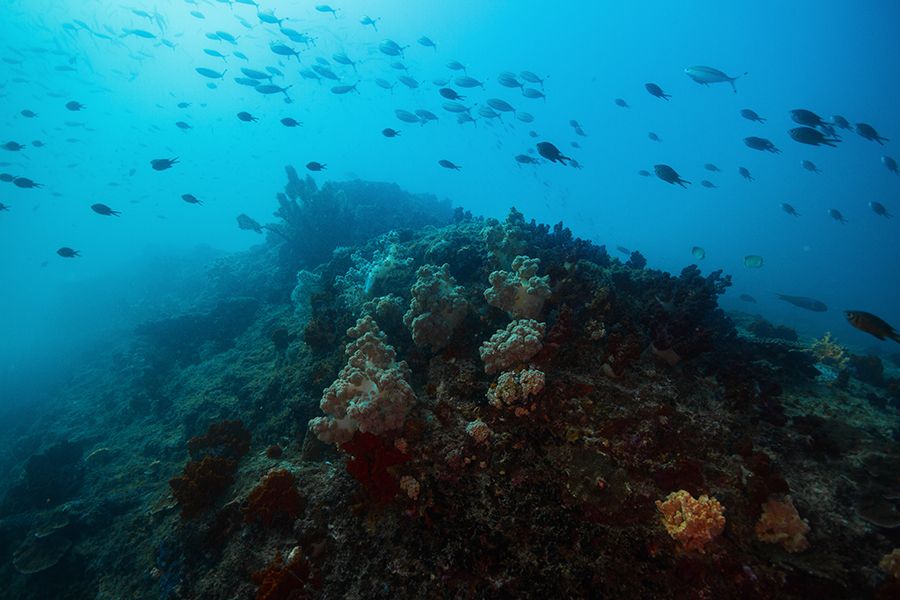
Dive level: Novice
Available from: Sandals Grenada
Purple Rain is an incredible dive site that has a bit of a romantic feel to it. It got its name from the beauty and precision of the purple creole wrasse that rain down into the area when they are swimming in formation, which they do often. While diving here, you’ll also see lots of colorful sponges, coral whips, and gorgonians, as well as scrawled filefish, black durgon, moray eels, and lobster. This healthy reef spans from 50 ft to near 90 ft, and it is easily one of the most populated reefs off Grenada.
Kohani
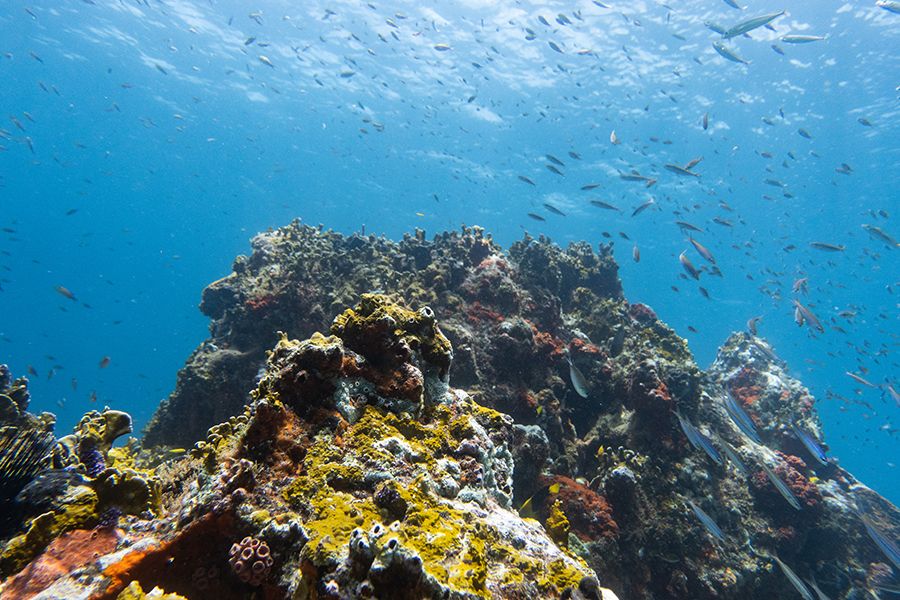
Dive level: Novice
Available from: Sandals Grenada
Kohani is located off of Point Salines, St. George’s. This is a shallow dive ranging from 20 ft to around 80 ft, and it is a combination of drift and reef dive. The water is usually calm here, but sometimes heavier currents pick up, so that’s something divers need to be aware of. This site is often described as a “natural aquarium” because of all the colorful sea life that can be found here like yellow, purple, and blue sponges. Sand channels can be seen between the healthy and vibrant corals. Sightings here may include scrawled filefish, blue and brown chromis, creole wrasse, and more.
Flamingo Bay
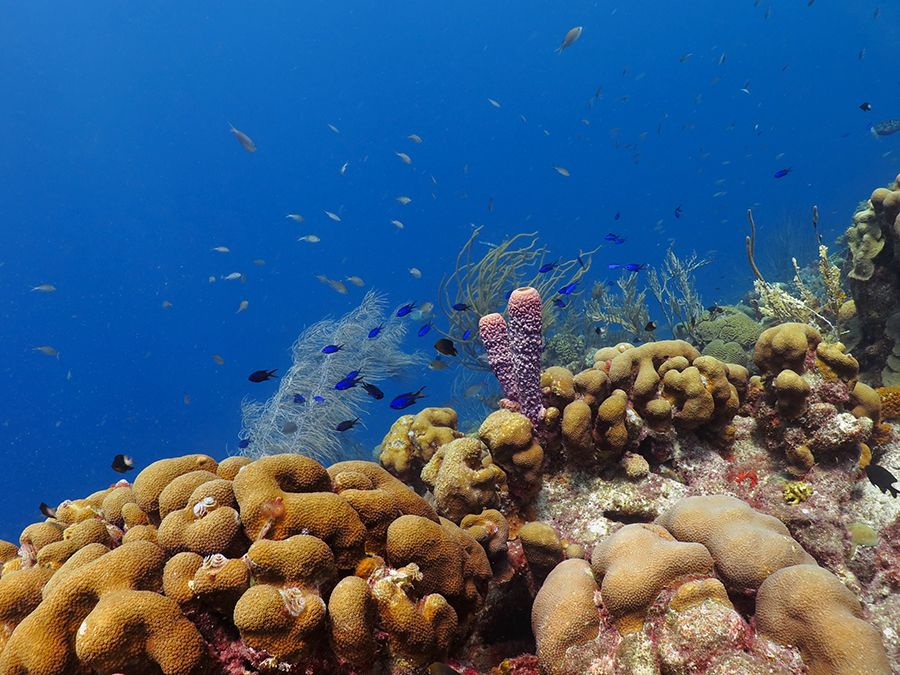
Dive level: Novice
Available from: Sandals Grenada
Flamingo Bay is great for both day and night diving. Divers love this location because they’re almost guaranteed to see something they wouldn’t elsewhere … like batfish, long stout sea horses, pipefish, and brindled jawfish to name a few. While diving here, you may also see spotted drums, bar jacks, creole wrasse, yellow tail snapper, chromis, garden eels, lobster, and many different types of hard and soft coral like elkhorn coral, ball, rope, and barrel sponges. The reef at Flamingo Bay ranges from 23 ft to 100 ft, and it is part of the Molinere Protected Seascape. Flamingo Bay is also a popular snorkeling location.
Molinere/Sculpture Park
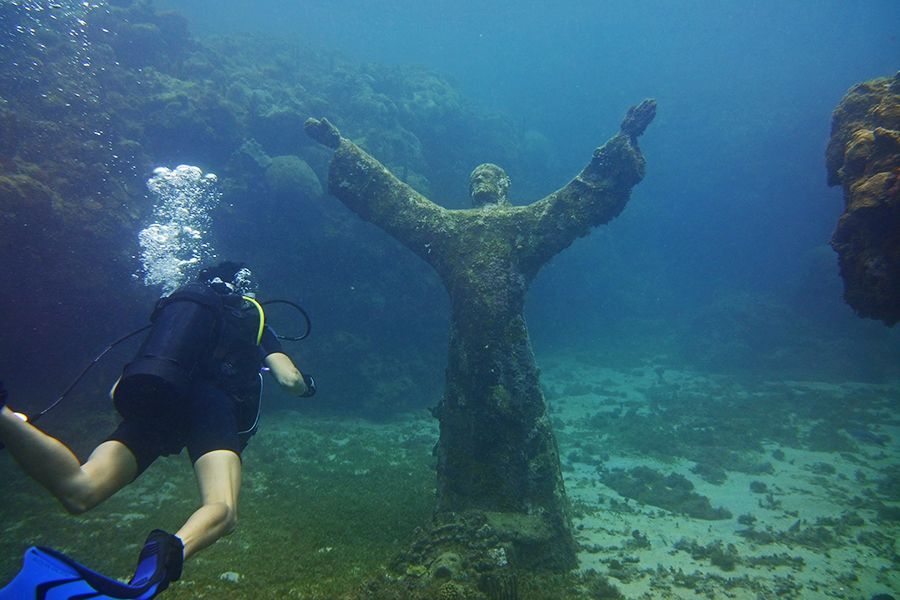
Dive level: Novice
Available from: Sandals Grenada
If you’re a diver, going to Grenada without visiting the Underwater Sculpture Park simply isn’t an option. This relatively shallow underwater sculpture park was created by British sculptor Jason de Caires Taylor with the aim of enhancing the Molinere Reef System. Over time, the sculptures made of cement and rebar have blended into the underwater scene and have helped to create new artificial reefs. The sculpture park’s featured structures tell the story of Grenada’s history, touching on culture and some of the things that make the island unique. Some of the sculptures have been damaged by bad weather over the years, but most of them still stand and are worth checking out while in Grenada.
Want to know more? Read our post on the Underwater Sculpture Park in Grenada.
Best dive sites in Antigua
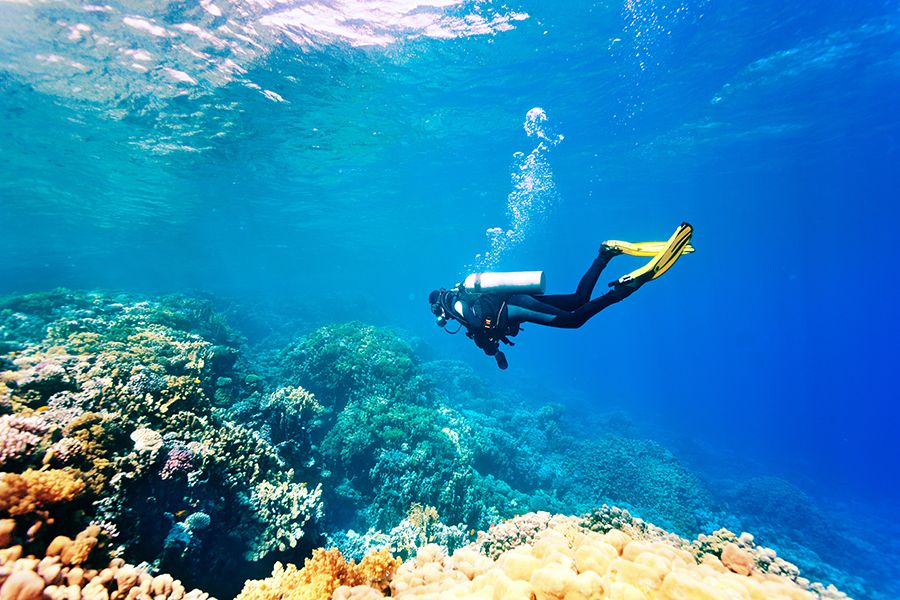
Not only is Antigua a truly romantic island destination with resorts like Sandals Grande Antigua that lead the way in love, but it is also a great option for divers who want to experience the best the Caribbean has to offer. We’ve listed a few of the most dived locations, but there are many more dive sites to explore in Antigua!
Mary Kay Reef
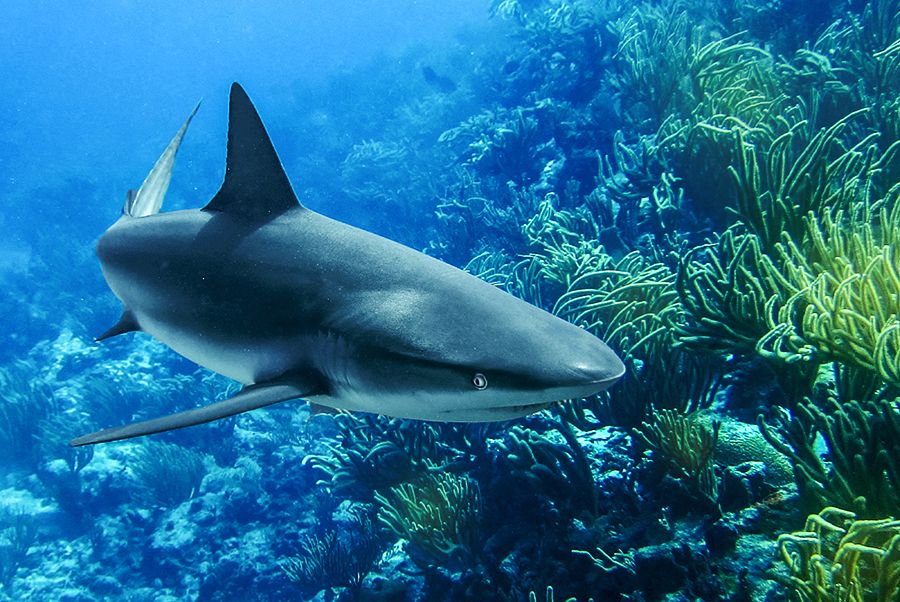
Dive level: Novice
Available from: Sandals Grande Antigua
Mary Kay Reef is an easy reef to get around, and there are lots of soft coral heads that attract marine species of all varieties. This reef is of the spur and grove variety with a few ledges and undercuts that you can explore as well. Expect to see turtles, lobster, barracuda, and sometimes even stingrays and reef sharks!
Monk’s Head
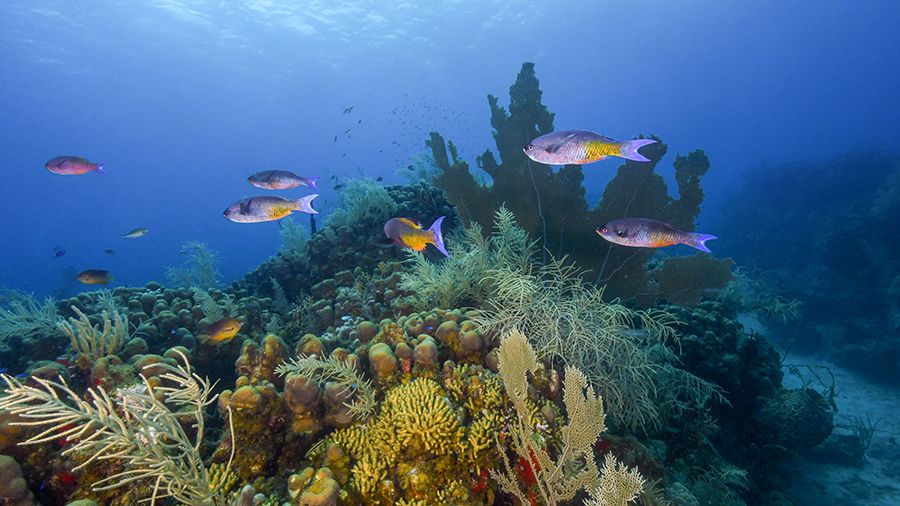
Dive level: Novice
Available from: Sandals Grande Antigua
With a maximum depth of around 50 ft, Monk’s Head is worth a visit while in Antigua. This is a straightforward dive that is best for divers who aren’t looking for anything too complicated. Monk’s Head is a defined coral knot where you can often see trumpet fish, snapper, parrotfish, creole wrasse, Atlantic spadefish, and southern stingrays.
Rambo’s Reef
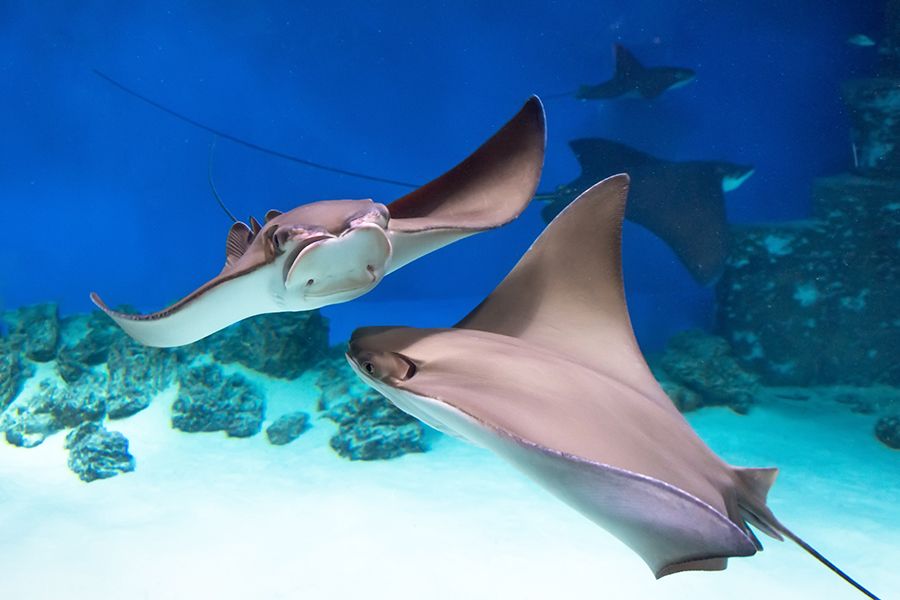
Dive level: Advanced
Available from: Sandals Grande Antigua
If you’re looking for some dive action that’ll keep you engrossed, look no further than Rambo’s Reef. This is a deeper water dive that requires a bit more experience. Explore the ledge while here, which is about 100 ft long. On the way back, take some time to appreciate and explore the valley, and look out for marine life like turtles, lobster, southern stingrays, and fish of all kinds!
Carpenter’s Rock
Dive level: Advanced
Available from: Sandals Grande Antigua
Carpenter’s Rock is a captivating and beautiful dive that’s a must for divers looking for an unforgettable experience while in Antigua. It stands out because of the captivating scenery, and the variety of marine life that passes through. You should try to book this dive on a day with good weather because there’s no mooring here and most dive operators will only go on calm days. Don’t expect this dive site to be crowded though - it’s a still mostly undiscovered gem.
Best dive sites in the Turks & Caicos Islands
The Turks & Caicos Islands are great for vacations centered on romance with a bit of diving or vacations that are all about diving with a bit of romance! Divers won’t want to miss out on scuba diving in Turks & Caicos at these and many other awesome locations.
Amphitheater
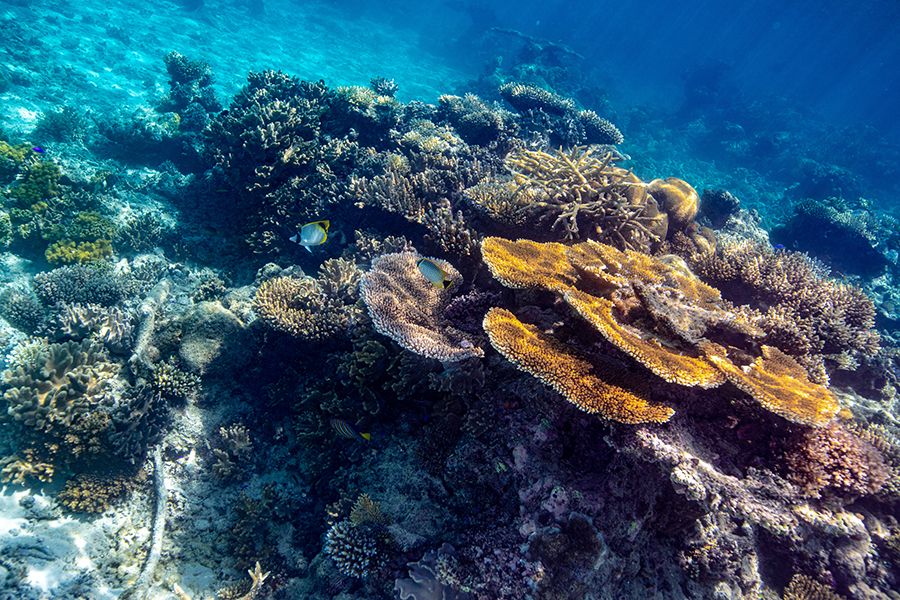
Dive level: Advanced
Accessible from: Beaches Turks and Caicos
The Amphitheater is part of the Columbus Landfall Marine National Park, which includes several other reefs. It is one of the standout reefs in the area because it really does have the feel of an amphitheater, which is something profound to experience underwater. There’s a bowl-like formation, with three sloping sides. As you settle in for your feature, you’ll be able to watch fish and other sea creatures as they go about their busy lives. Expect to see creole wrasse, snapper, horse-eyed jacks, blue parrotfish, queen triggerfish, sea urchins, turtles, lobster, and occasionally, reef sharks. Other sightings include elephant ear sponges, orange rope sponges, plate corals, and black coral. The Amphitheater extends a whopping 1000 ft from shore and drops thousands of feet into the deep.
Aquarium
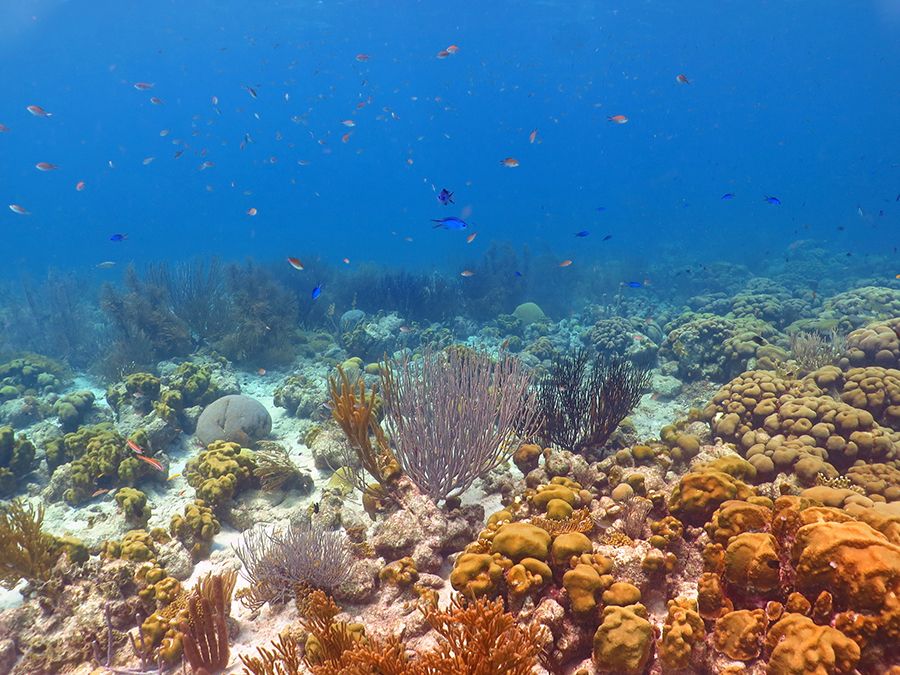
Dive level: Advanced
Accessible from: Beaches Turks and Caicos
Who doesn’t want to feel as though they’re swimming in a life-sized aquarium while diving in the warm waters of the Caribbean? Check that experience off your bucket list with a visit to Aquarium! There, you can swim with large schools of grunts and snapper that seem a permanent fixture near the top of the wall. This dive site has spur and grove type features and includes sand chutes that go through the reef, all the way to the 100 ft point. Other sightings include turtles, nurse sharks, and sometimes grey reef sharks.
Molasses Reef
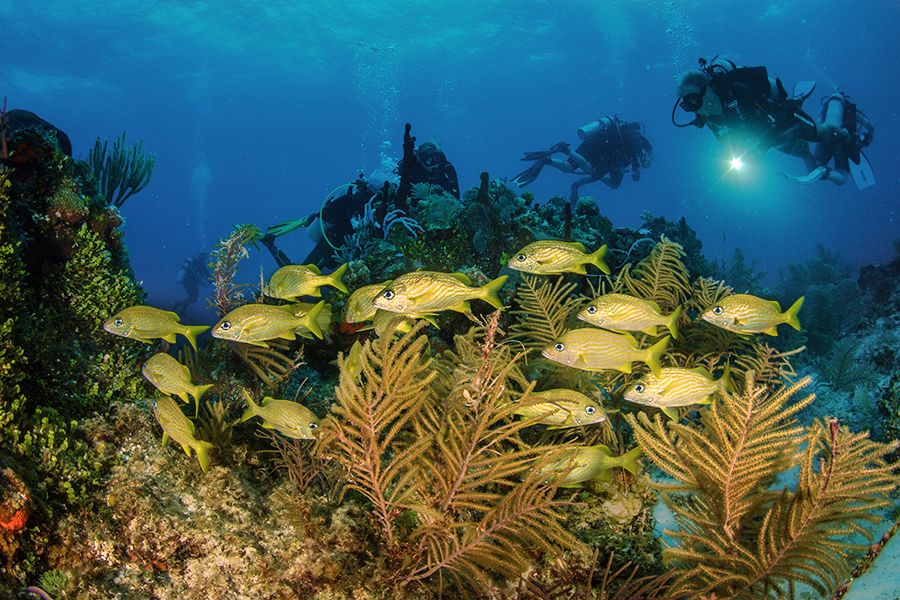
Dive level: Novice
Accessible from: Beaches Turks and Caicos
As far as reefs go in the Turks & Caicos, the Molasses Reef near French Cay is one of the most pristine. There are many points of attraction here, such as shipwrecks on the shallow end, one-of-a-kind coral formations, and sightings of larger marine life like turtles, spotted eagle rays, and sharks. There’s a vertical wall here that’s interesting to explore for deeper diving. Near the top of the reef, you’ll spot fish like groupers and jacks. One of the most fun things about this dive site though has to be Jojo the dolphin, who seems always to be around and is a thrill to witness!
Shark Hotel
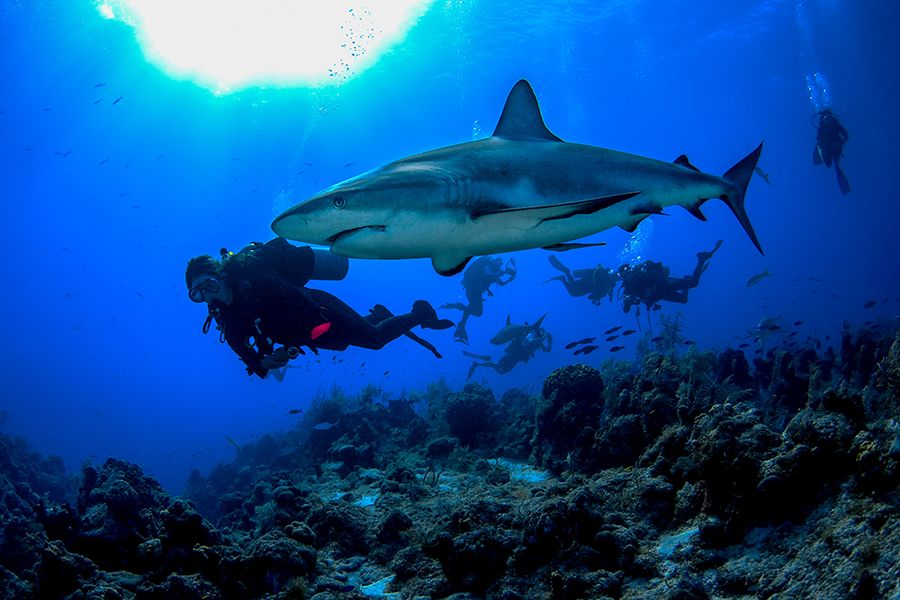
Dive level: Advanced
Accessible from: Beaches Turks and Caicos
The name tells you what to expect, and you’re unlikely to be disappointed at Shark Hotel. This dive site is off Northwest Point, Providenciales, and it is highly regarded by seasoned divers. Lots of reef sharks swim in and out of this area. You may also come across grunts, snapper, and goatfish, particularly at the top of the wall. The wall starts at 45 ft and extends to over 150 ft. This dive is a sure thrill, and not for the faint of heart!
Diving with Sandals Resorts
Sandals all-inclusive resorts are known for their wide range of inclusions, like scuba and snorkeling. Inclusive vacations of this nature appeal to guests who want value for money, especially since diving can get expensive as a standalone. With resorts in Jamaica, Grenada, Barbados, The Bahamas, Saint Lucia, and Antigua, Sandals covers some of the best dive locations in the Caribbean - you’re pretty much guaranteed to have some really great dive experiences!
Sandals is a great resort to dive with, whether you’re a beginner who’s planning on getting your PADI® certification on the property (more on that later), or you've been diving for a while and want to try a new destination with a dive team you can trust.
The Sandals all-inclusive concept equates to pure bliss for dive couples as diving is included in their stay. At all Sandals resorts including Sandals Grenada, Sandals Grande Antigua, Sandals all-inclusive resorts in St. Lucia, Sandals all-inclusive resorts in Jamaica, Sandals all-inclusive resorts in The Bahamas, and Sandals all-inclusive resorts in Barbados, you’ll be able to dive for free once you’re certified (up to 2 tanks per day). Beaches Turks & Caicos and Beaches’ resorts in Jamaica are also great options for all-inclusive vacations in the Caribbean.
What makes Sandals vacations even more amazing is that even if only one person wants to spend all their time diving, there are plenty of other things to do on the property to keep everyone entertained!
Getting PADI® certified with Sandals
You can either come to Sandals with a love for diving or discover it ‘accidentally’ after completing a certification course at the resort. Either way, you can dive right in at Sandals, and get your PADI® certification done right at the resort for the regular PADI® associated cost. Once you’re certified, you can dive for free for the duration of your vacation (2 tanks per day).
If you decide to get PADI® certified, speed up the process by doing some e-learning before you arrive. Check out some of the comprehensive Sandals scuba diving courses, and Sandals scuba dive sites.
What to do once you arrive at Sandals for your dive vacation
Once you settle in for your luxury-included vacation at Sandals, one of the first things you’ll want to do is check in at the dive shop where you can tweak the details for your dives (if needed), and get familiar with the team. Doing this can give you a better idea of what to expect. You can make arrangements to get your PADI® Open Water certification here, or if you are already certified, find out about upgrading to a higher dive level.
Want to skip the PADI® certification process? To scuba dive at the resort, you don’t need to be PADI® certified! The staff at the dive shop can tell you all about the basic resort scuba course. This usually takes around 3 hours to complete, and then you can dive. Resort certification (unlike PADI® certification) is only good for your current stay. For future trips, it will be necessary to do this all over again, which is why PADI® certification is a preference for some divers. Resort certification also has limitations – you can only do dives up to 40 ft in depth.
Diving safely
The only way you should dive is safely! That’s why it’s so important to get certified before you start exploring. Some of the things you can do once you’re past the point of certification include double-checking your equipment before diving in and paying attention to the instructions from your dive team. Once underwater, stay close to your dive buddy, and keep watch for underwater signals. Getting dive insurance also doesn’t hurt!
Dive right into the best scuba diving sites in the Caribbean
When it comes to scuba, the Caribbean does not disappoint – the best scuba diving can truly be found in this region. With so many tranquil and beautiful islands to choose from, it’s not about which island you will go to, but which island you want to go to first!
Endless adventures await…
